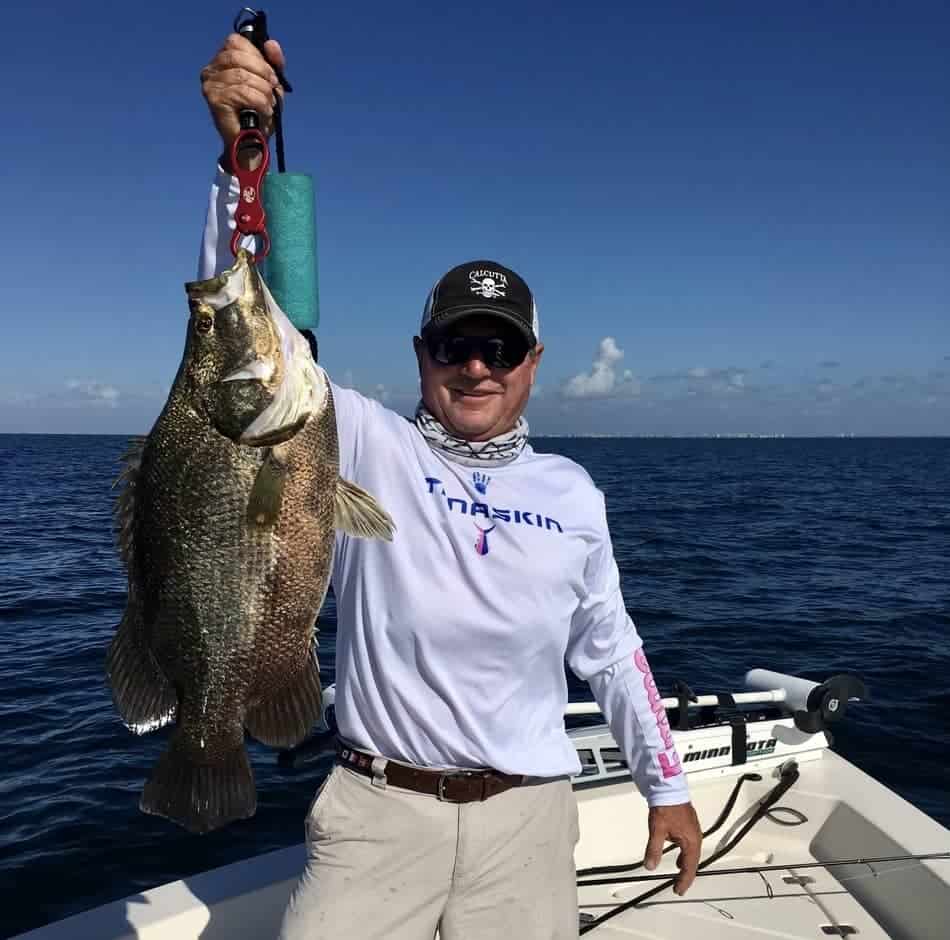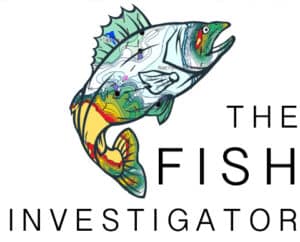
Catching Tripletail is no easy feat. Tripletail are like Goldilocks, you need to present everything “just right” to land one of these prehistoric fish, but once you do, they are a blast to fight and delicious to eat!
How To Catch Tripletail
Tripletail are caught sight fishing with small live bait and artificial lures on floating structures, including crab buoys, sargassum weed, and pilings. Tripletail are skittish fish, so using small fishing tackle while keeping your distance will increase your chances of catching them.
Tripletail are an exciting fish to catch because of their strong fighting ability and unique nature in which they are targeted. Let’s take an in-depth look into how to catch these prehistoric fish, as well as talk about the best-kept secrets to catching monster Tripletail.
Running The Buoys For Tripletail
The most common way to catch Tripletail is by sight fishing. Sight fishing for Tripletail typically involves a fishing technique called “running the buoys,” which starts by finding rows of buoys laid out by crab fishermen. When you find a good row of buoys, keep a distance of about 30′ to avoid spooking the fish.
When you find your first Tripletail, you will notice they are incredibly skittish fish, often immediately diving deep as anglers approach them. If you can make long casts and keep your distance from the structure they inhabit, you will dramatically increase your chance of catching them.
Tripletail Love a Natural Bait Presentation
It is best to stop the boat up-current from where the Tripletail is inhabiting and casting about five feet from the fish and let the current do the rest of the work of presenting your bait naturally. If there is no current at the time of fishing, I have always had great success casting a few feet past the fish and slowly retrieving my bait, pausing the moment I am directly over them. If the fish is hungry, they will slowly swim in the direction of your bait, consuming it as soon as they reach it.
Tripletail Can Be Picky, So Be Ready To Present Different Options
Sometimes they will swim out to investigate your baitfish only to swim back to the structure where they are inhabiting. When this happens, it typically means one of two things.
First, Tripletail may not be interested in the bait you presented them, whether that be the size or type of bait presented. This is the case most of the time, and simply throwing a different-sized bait or switching up to a different bait fish or crustacean, like shrimp, can be all it takes to have them take your bait.
The second reason they may be uninterested in your bait presentation is that your tackle is too heavy. This may be your issue if you are using a 30lb plus leader or tying your hook directly to braid. By simply stepping down leader size and or your hook size, you may get them to change their mind about your bait instantly.
Expert Tips On Catching Tripletail
- Early bird gets the tripletail! Getting out early in the morning before other anglers are on the water will dramatically increase your chances of finding Tripletail on floating structures. Most of the nearshore Tripletail get picked off early in the morning, requiring anglers to head offshore a couple of miles to have success.
- Keep Your Distance! Tripletail are skittish, so it’s essential to keep your distance and make a long cast. I have always had the best luck when I cast 5′ to 10′ past them and slowly retrieve the bait. Once the bait is within a couple of feet of our targeted fish, I pause. This pause is often all it takes to get the fish to dart away from its buoy to prey on the bait.
- Big fish are not stupid! Large Tripletail did not make it to their size by being stupid. When you come upon a larger fish, it is extremely important to keep your distance and cast light to moderate tackle their way. If they are not taking your bait, try casting out another rod with a slightly smaller hook and leader diameter.
- Get a birds-eye view! If you are targeted Tripletail from a boat with a tower, have one of the anglers get up on the tower. Once on the tower, you will drastically increase your overall ability to see the fish camouflaging themselves underneath their structures.
- Bring Your Polarized Glasses! Tripletail are almost always caught sight fishing, so it’s essential that you bring your polarized glasses to see them.
Best Fishing Tackle for Tripletail
When fishing for a Tripletail, you can quickly improve your chances of success by fishing with the correct tackle. As mentioned earlier, Tripletail are highly skittish fish, so it is essential that we maximize our casting distance by choosing the correct tackle. Also, selecting the right leader and hook size will give you a more natural bait presentation.
Best Fishing Rods for Tripletail
When choosing a rod for Tripletail, it is important to get a lightweight and manageable setup while also having some length to increase your casting distance. When targeting Tripletail, my favorite rod to fish is St. Croix’s 7’6 medium, fast action Premier Series.
The St.Croix Premier Series offers excellent rods at a fraction of the price of many other rod brands. The 7’6″ rod will give you the added casting distance needed to make a large distance cast while being small enough to manage while fishing from a boat.
Best Reels for Tripletail
Even small Tripletail are great fighters, so having a reel with a moderate to max drag rating is essential. Reels with 15lb max drag and above make great nearshore options, especially when fishing for Tripletail.
A few great reels that I have found consistently reliable include the Battle III, Daiwa BG, and the Shimano Vanguard.
Best Fishing Line To Optimize Casting Distance
Maximizing casting distance is essential to a successful day fishing for Tripletail. I recommend using Power Pro Spectra Fiber Braid in a 20-30lb test.
Best Tripletail Fishing Leader
When it comes to targeting tripletail, the smaller the leader diameter, the more bits you will get. I highly recommend using a 20-pound fluorocarbon leader. The Super FC Sniper by Sunline will dramatically increase the amount of fish you get to bite. Leader length is also an important factor to keep in mind. I have found that a 4’-5′ fluorocarbon leader has worked best.
Expert Tip: Have more than 1 rod rigged and ready to go with different leader strengths and hook sizes. Some Tripletail will not be fooled by the 30lb fluorocarbon but will not see anything coming with the 20lb fluorocarbon.
Best Hooks for Tripletail
Tripletail are often hook shy, so use a small hook in a 1/0 to 2/0 size.
What Do Tripletail Eat?
Tripletail are opportunistic feeders often preying on a wide variety of baits and crustaceans, including:
- Menhaden
- Bumper
- Glass minnows
- Shrimp
- Crab
- Squid
No Bait, No Problem. Here Are 5 Artificial Lures I Love For Tripletail
Though Tripletail are often caught using live bait, predominantly shrimp, they are frequently caught using artificial lures.
Here are 5 of the best lures for targeting Tripletail
- 4″ New Penny Gulp
- Gulp Peeler Crabs
- Swim Baits
- Shrimp Flys
- Crab Fly
When Can You Catch Tripletail?
Tripletail are caught year-round but are found in different depths depending on the time of year. Tripletail prefer deeper waters between October and April and shallower waters in May through September.
Where Can You Catch Tripletail?
Tripletail are caught inhabiting floating debris in tropical and subtropical waters. Though Tripletail can be caught throughout the ocean, they are the most prevalent nearshore in 20 to 30 feet of water.
In the Gulf of Mexico, Tripletail are often found offshore in winter and nearshore in the summer. Some of the floating structures Tripletail inhabit include navigation markers, moored boats, sargassum weed, and buoys.
Anglers often find Tripletail using a fishing technique called “running the buoys” this technique is achieved by locating a long line of buoys in 20’-50′ of water and individually site fishing these fish as you cruise by each one.
Tripletail are often floating on their sides directly adjacent to the buoys. When swimming near the buoys, they can be extremely hard to see, so it is essential that all anglers have a quality pair of polarised glasses to locate these fish better.
Let’s take a deeper dive into how to catch Tripletail by learning more about this unique fish as a whole.
What Are Tripletail Fish?
If you haven’t already heard about the prehistoric-looking Tripletail, you are in for a treat. These ugly-looking fish have recently been enjoying their time in the spotlight from many inshore and nearshore anglers.
Tripletail, often called by many names, including blackfish, flasher, and my favorite, steamboat, is found worldwide in tropical and subtropical waters. Tripletail anal and pectoral fins fall far back on this fish, giving them the appearance of having three tails, hence the name. Many freshwater anglers have commented on their resemblance to large crappie.
Tripletail have small eyes and a small head that seem disproportional to the rest of their body. Young tripletail are often lighter in appearance, with black, brown, and grey blotches slowly changing to a dark brownish-black as they hit maturity. Tripletail are aggressive fighters often impressing anglers with their strong fighting ability compared to their size.
Is Tripletail Good To Eat?
Tripletail is phenomenal eating, often being compared to snapper and grouper. The flesh is white, flaky, and sweet. Tripletail are prized for their meat, but they are difficult to fillet because of the size of their rib cage. Because of this, Many anglers gut them and cook them whole.
Is Tripletail High In Mercury?
Tripletail is not high in mercury and can safely be consumed a couple of times a week.
Are Tripletail In The Same Family As Grouper?
Though Tripletail and grouper share some physical characteristics, they are not in the same family. Tripletail are in the Lobotidae family, where grouper are in the Serranidae family.
Are Tripletail Poisonous?
Tripletail are not poisonous.
Do Tripletail Have Teeth?
Tripletail have small canonical teeth on both top and bottom lips. It is also important to note that Tripletails have a razor-sharp serrated preopercle, which is essentially an additional gill plate.
Do Tripletail Have A Size Limit?
Tripletail must be a minimum of 18″ to be harvested in the Gulf of Mexico and in the Atlantic. Anglers can keep a maximum of 2 fish per person.
Tripletail Natural Predators
Tripletail are preyed upon by many species of shark in the Atlantic and Gulf coast.
Tripletail Fun Facts
- During Maturation tripletail slowly become darker
- Tripletail have chameleon-like abilities to shift their skin color from dark browns, blacks, yellows, and grey to camouflage themselves to whatever structure they inhabit.
- Tripletail are constantly breeding, often known to breed up to 30 times in as little as 90 days.
- Tripletail are solitary fish often inhabiting some form of floating structure alone.
